NWP_Query Object
(
[query] => Array
(
[post_type] => kb
[post__not_in] => Array
(
[0] => 36854
)
[tax_query] => Array
(
[0] => Array
(
[taxonomy] => kbtopic
[field] => slug
[terms] => modifications
)
)
[posts_per_page] => 4
[orderby] => rand
)
[query_vars] => Array
(
[post_type] => kb
[post__not_in] => Array
(
[0] => 36854
)
[tax_query] => Array
(
[0] => Array
(
[taxonomy] => kbtopic
[field] => slug
[terms] => modifications
)
)
[posts_per_page] => 4
[orderby] => meta_value_num menu_order
[error] =>
[m] =>
[p] => 0
[post_parent] =>
[subpost] =>
[subpost_id] =>
[attachment] =>
[attachment_id] => 0
[name] =>
[pagename] =>
[page_id] => 0
[second] =>
[minute] =>
[hour] =>
[day] => 0
[monthnum] => 0
[year] => 0
[w] => 0
[category_name] =>
[tag] =>
[cat] =>
[tag_id] =>
[author] =>
[author_name] =>
[feed] =>
[tb] =>
[paged] => 0
[meta_key] =>
[meta_value] =>
[preview] =>
[s] =>
[sentence] =>
[title] =>
[fields] =>
[menu_order] =>
[embed] =>
[category__in] => Array
(
)
[category__not_in] => Array
(
)
[category__and] => Array
(
)
[post__in] => Array
(
)
[post_name__in] => Array
(
)
[tag__in] => Array
(
)
[tag__not_in] => Array
(
)
[tag__and] => Array
(
)
[tag_slug__in] => Array
(
)
[tag_slug__and] => Array
(
)
[post_parent__in] => Array
(
)
[post_parent__not_in] => Array
(
)
[author__in] => Array
(
)
[author__not_in] => Array
(
)
[search_columns] => Array
(
)
[meta_query] => Array
(
[relation] => OR
[0] => Array
(
[key] => mkb_tax_order_5742
[compare] => EXISTS
)
[1] => Array
(
[key] => mkb_tax_order_5742
[compare] => NOT EXISTS
)
)
[order] => ASC
[ignore_sticky_posts] =>
[suppress_filters] =>
[cache_results] => 1
[update_post_term_cache] => 1
[update_menu_item_cache] =>
[lazy_load_term_meta] => 1
[update_post_meta_cache] => 1
[nopaging] =>
[comments_per_page] => 50
[no_found_rows] =>
[taxonomy] => kbtopic
[term] => modifications
)
[tax_query] => WP_Tax_Query Object
(
[queries] => Array
(
[0] => Array
(
[taxonomy] => kbtopic
[terms] => Array
(
[0] => modifications
)
[field] => slug
[operator] => IN
[include_children] => 1
)
)
[relation] => AND
[table_aliases:protected] => Array
(
[0] => wp_term_relationships
)
[queried_terms] => Array
(
[kbtopic] => Array
(
[terms] => Array
(
[0] => modifications
)
[field] => slug
)
)
[primary_table] => wp_posts
[primary_id_column] => ID
)
[meta_query] => WP_Meta_Query Object
(
[queries] => Array
(
[0] => Array
(
[key] => mkb_tax_order_5742
[compare] => EXISTS
)
[1] => Array
(
[key] => mkb_tax_order_5742
[compare] => NOT EXISTS
)
[relation] => OR
)
[relation] => OR
[meta_table] => wp_postmeta
[meta_id_column] => post_id
[primary_table] => wp_posts
[primary_id_column] => ID
[table_aliases:protected] => Array
(
[0] => wp_postmeta
[1] => mt1
)
[clauses:protected] => Array
(
[wp_postmeta] => Array
(
[key] => mkb_tax_order_5742
[compare] => EXISTS
[compare_key] => =
[alias] => wp_postmeta
[cast] => CHAR
)
[mt1] => Array
(
[key] => mkb_tax_order_5742
[compare] => NOT EXISTS
[compare_key] => =
[alias] => mt1
[cast] => CHAR
)
)
[has_or_relation:protected] => 1
)
[date_query] =>
[queried_object] => WP_Term Object
(
[term_id] => 5742
[name] => Modifications
[slug] => modifications
[term_group] => 0
[term_taxonomy_id] => 5742
[taxonomy] => kbtopic
[description] =>
[parent] => 5739
[count] => 8
[filter] => raw
[term_order] => 2
)
[queried_object_id] => 5742
[request] => SELECT SQL_CALC_FOUND_ROWS wp_posts.ID
FROM wp_posts LEFT JOIN wp_term_relationships ON (wp_posts.ID = wp_term_relationships.object_id) LEFT JOIN wp_postmeta ON ( wp_posts.ID = wp_postmeta.post_id ) LEFT JOIN wp_postmeta AS mt1 ON ( wp_posts.ID = mt1.post_id AND mt1.meta_key = 'mkb_tax_order_5742' )
WHERE 1=1 AND wp_posts.ID NOT IN (36854) AND (
wp_term_relationships.term_taxonomy_id IN (5742)
) AND (
wp_postmeta.meta_key = 'mkb_tax_order_5742'
OR
mt1.post_id IS NULL
) AND ((wp_posts.post_type = 'kb' AND (wp_posts.post_status = 'publish' OR wp_posts.post_status = 'acf-disabled')))
GROUP BY wp_posts.ID
ORDER BY wp_postmeta.meta_value+0 ASC, wp_posts.menu_order ASC
LIMIT 0, 4
[posts] => Array
(
[0] => WP_Post Object
(
[ID] => 36820
[post_author] => 23
[post_date] => 2021-04-29 17:00:58
[post_date_gmt] => 2021-04-30 00:00:58
[post_content] =>
Modification
Increase LED timing circuit.
Difficulty Level
3 - Moderate - removal or replacement of internal components.
Components Required
- Capacitor:
- 220 µfd, 16V, ~2 minutes
- 470 µfd, 16V, ~4 minutes
- 1000 µfd, 16V, ~5 minutes
Instructions
- Remove and replace C3 on the main PC board of the LEF Series master station with a different value capacitor to achieve the desired LED timing length.
- LEDs will stay illuminated for the duration of the timing circuit from the moment the last sub station places a call.
LEF Master Stations
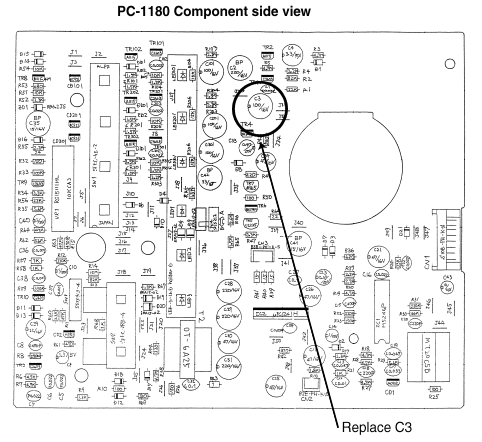
Locate and replace capacitor C3. Change value to a higher level to reach the desired timing circuit length.
- 220 µfd, 16V, ~2 minutes
- 470 µfd, 16V, ~4 minutes
- 1000 µfd, 16V, ~5 minutes
[mkb-info]The capacitor is in the same area on the PC board for both the LEF and LEF-C master stations.[/mkb-info]
LEF-10C Master station

Locate and replace capacitor C3. Change value to a higher level to reach the desired timing circuit length.
- 220 µfd, 16V, ~2 minutes
- 470 µfd, 16V, ~4 minutes
- 1000 µfd, 16V, ~5 minutes
[post_title] => Increase timing circuit of call-in LED
[post_excerpt] =>
[post_status] => publish
[comment_status] => open
[ping_status] => open
[post_password] =>
[post_name] => increase-timing-circuit-of-call-in-led
[to_ping] =>
[pinged] =>
[post_modified] => 2025-03-12 08:40:45
[post_modified_gmt] => 2025-03-12 15:40:45
[post_content_filtered] =>
[post_parent] => 0
[guid] => https://aiphone.local/kb/increase-timing-circuit-of-call-in-led/
[menu_order] => 0
[post_type] => kb
[post_mime_type] =>
[comment_count] => 0
[filter] => raw
)
[1] => WP_Post Object
(
[ID] => 36831
[post_author] => 23
[post_date] => 2021-04-29 17:15:42
[post_date_gmt] => 2021-04-30 00:15:42
[post_content] =>
Modification
Eliminate incoming call tone from sub station at a master station.
Difficulty Level
3 - Moderate - removal or replacement of internal components.
Components Required
N/A
Instructions
- LEF-3/3C: remove transistor TR7.
- LEF-5/5C: remove transistor TR7.
- LEF-10/10S: remove transistor TR8.
- LEF-10C: remove transistor T7.
LEF-3
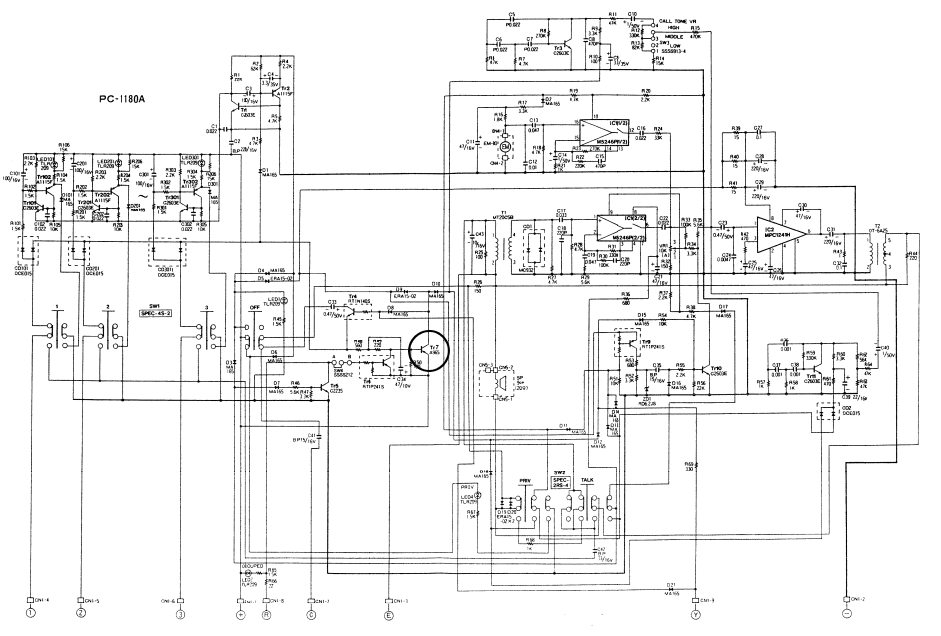
LEF-5
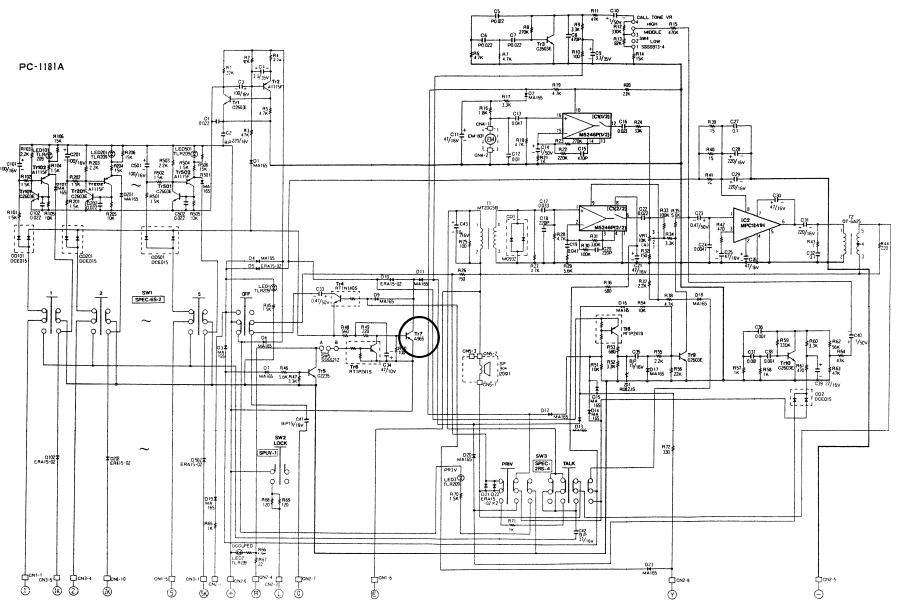
LEF-10
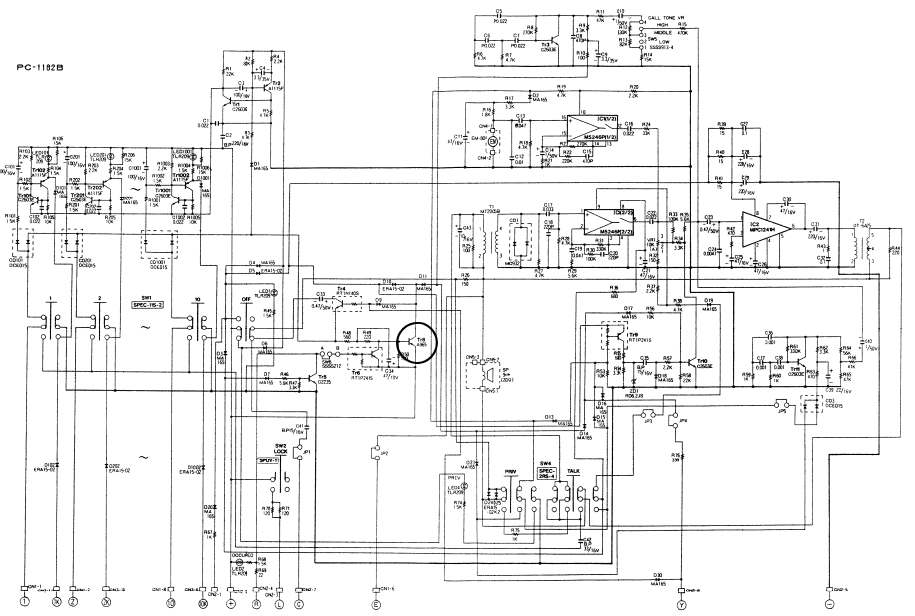
[post_title] => Eliminating Call Tone from Sub Station at LEF Master Station
[post_excerpt] =>
[post_status] => publish
[comment_status] => open
[ping_status] => open
[post_password] =>
[post_name] => eliminating-call-tone-from-sub-station-at-lef-master-station
[to_ping] =>
[pinged] =>
[post_modified] => 2025-03-12 08:40:57
[post_modified_gmt] => 2025-03-12 15:40:57
[post_content_filtered] =>
[post_parent] => 0
[guid] => https://aiphone.local/kb/eliminating-call-tone-from-sub-station-at-lef-master-station/
[menu_order] => 0
[post_type] => kb
[post_mime_type] =>
[comment_count] => 0
[filter] => raw
)
[2] => WP_Post Object
(
[ID] => 36836
[post_author] => 23
[post_date] => 2021-04-29 16:47:14
[post_date_gmt] => 2021-04-29 23:47:14
[post_content] =>
Modification
Installing a volume control on an LE Series sub station.
Difficulty Level
5 - Hard - circuit creation and internal addition.
Components Required
- Variable resistor: 50 ~ 250 Ω, 1 W
- Resistor: 33 Ω, 1 W
Instructions
- Install components as shown on the diagram.
- No physical provisions are made on the sub station for the addition of a volume control. Chassis modification is required.
LE-A

LE-AN
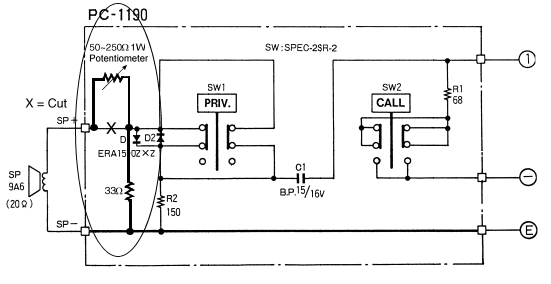
[mkb-info]Add components as shown above. Volume control will affect communication and call tone volume.[/mkb-info]
[post_title] => Installing Volume Control on LE Series Sub Station
[post_excerpt] =>
[post_status] => publish
[comment_status] => open
[ping_status] => open
[post_password] =>
[post_name] => installing-volume-control-on-le-series-sub-station
[to_ping] =>
[pinged] =>
[post_modified] => 2025-03-12 08:40:58
[post_modified_gmt] => 2025-03-12 15:40:58
[post_content_filtered] =>
[post_parent] => 0
[guid] => https://aiphone.local/kb/installing-volume-control-on-le-series-sub-station/
[menu_order] => 0
[post_type] => kb
[post_mime_type] =>
[comment_count] => 0
[filter] => raw
)
[3] => WP_Post Object
(
[ID] => 36840
[post_author] => 23
[post_date] => 2021-04-29 17:20:33
[post_date_gmt] => 2021-04-30 00:20:33
[post_content] =>
Modification
LED monitoring indicator on an LE series sub station. This modification allows users to know that their station is being monitored by a master station.
Difficulty Level
5 - Hard - circuit creation and internal addition.
Components Required
- Resistor: 1K Ω, 0.25 W
- LED: general purpose
Instructions
- Run two extra wires to each sub station requiring the modification. (Only one extra wire is required when using LE-C, LE-CN, or LE-DL.)
- Install LED and resistor as shown on diagram.
- When a master station selects that sub station, the LED will illuminate.
- No physical provisions are made on the sub station for the addition of an LED. Chassis modification or external mounting is required.
Diagram
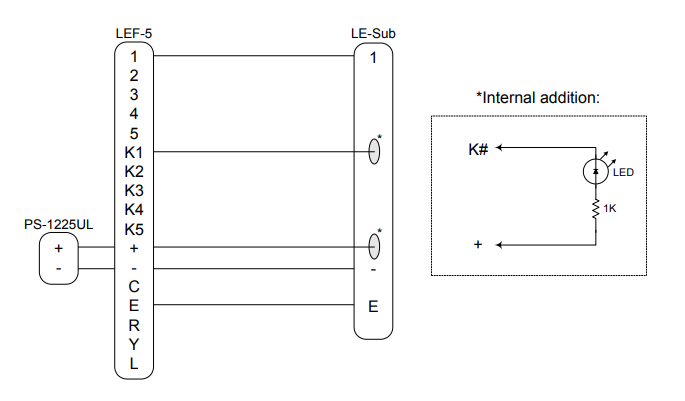
Notes:
- Inside the sub station, install the general-purpose LED and 1K Ω resistor as shown above.
- Since there is no designated location for placement of the LED, either modify the chassis of the sub station or mount the LED externally.
- The LE-C, LE-CN and LE-DL already have the "+" wire connected to them. Only the "K" wire will need to be added with those models.
[post_title] => LED Monitoring Indicator on an LE Series Sub Station
[post_excerpt] =>
[post_status] => publish
[comment_status] => open
[ping_status] => open
[post_password] =>
[post_name] => led-monitoring-indicator-on-an-le-series-sub-station
[to_ping] =>
[pinged] =>
[post_modified] => 2025-03-12 08:40:59
[post_modified_gmt] => 2025-03-12 15:40:59
[post_content_filtered] =>
[post_parent] => 0
[guid] => https://aiphone.local/kb/led-monitoring-indicator-on-an-le-series-sub-station/
[menu_order] => 0
[post_type] => kb
[post_mime_type] =>
[comment_count] => 0
[filter] => raw
)
)
[post_count] => 4
[current_post] => -1
[before_loop] => 1
[in_the_loop] =>
[post] => WP_Post Object
(
[ID] => 36820
[post_author] => 23
[post_date] => 2021-04-29 17:00:58
[post_date_gmt] => 2021-04-30 00:00:58
[post_content] =>
Modification
Increase LED timing circuit.
Difficulty Level
3 - Moderate - removal or replacement of internal components.
Components Required
- Capacitor:
- 220 µfd, 16V, ~2 minutes
- 470 µfd, 16V, ~4 minutes
- 1000 µfd, 16V, ~5 minutes
Instructions
- Remove and replace C3 on the main PC board of the LEF Series master station with a different value capacitor to achieve the desired LED timing length.
- LEDs will stay illuminated for the duration of the timing circuit from the moment the last sub station places a call.
LEF Master Stations

Locate and replace capacitor C3. Change value to a higher level to reach the desired timing circuit length.
- 220 µfd, 16V, ~2 minutes
- 470 µfd, 16V, ~4 minutes
- 1000 µfd, 16V, ~5 minutes
[mkb-info]The capacitor is in the same area on the PC board for both the LEF and LEF-C master stations.[/mkb-info]
LEF-10C Master station

Locate and replace capacitor C3. Change value to a higher level to reach the desired timing circuit length.
- 220 µfd, 16V, ~2 minutes
- 470 µfd, 16V, ~4 minutes
- 1000 µfd, 16V, ~5 minutes
[post_title] => Increase timing circuit of call-in LED
[post_excerpt] =>
[post_status] => publish
[comment_status] => open
[ping_status] => open
[post_password] =>
[post_name] => increase-timing-circuit-of-call-in-led
[to_ping] =>
[pinged] =>
[post_modified] => 2025-03-12 08:40:45
[post_modified_gmt] => 2025-03-12 15:40:45
[post_content_filtered] =>
[post_parent] => 0
[guid] => https://aiphone.local/kb/increase-timing-circuit-of-call-in-led/
[menu_order] => 0
[post_type] => kb
[post_mime_type] =>
[comment_count] => 0
[filter] => raw
)
[comment_count] => 0
[current_comment] => -1
[found_posts] => 7
[max_num_pages] => 2
[max_num_comment_pages] => 0
[is_single] =>
[is_preview] =>
[is_page] =>
[is_archive] => 1
[is_date] =>
[is_year] =>
[is_month] =>
[is_day] =>
[is_time] =>
[is_author] =>
[is_category] =>
[is_tag] =>
[is_tax] => 1
[is_search] =>
[is_feed] =>
[is_comment_feed] =>
[is_trackback] =>
[is_home] =>
[is_privacy_policy] =>
[is_404] =>
[is_embed] =>
[is_paged] =>
[is_admin] =>
[is_attachment] =>
[is_singular] =>
[is_robots] =>
[is_favicon] =>
[is_posts_page] =>
[is_post_type_archive] => 1
[query_vars_hash:WP_Query:private] => 75caac21e12a4f44e67c216d10fa0c05
[query_vars_changed:WP_Query:private] => 1
[thumbnails_cached] =>
[allow_query_attachment_by_filename:protected] =>
[stopwords:WP_Query:private] =>
[compat_fields:WP_Query:private] => Array
(
[0] => query_vars_hash
[1] => query_vars_changed
)
[compat_methods:WP_Query:private] => Array
(
[0] => init_query_flags
[1] => parse_tax_query
)
)

 Locate and replace capacitor C3. Change value to a higher level to reach the desired timing circuit length.
Locate and replace capacitor C3. Change value to a higher level to reach the desired timing circuit length.
 Locate and replace capacitor C3. Change value to a higher level to reach the desired timing circuit length.
Locate and replace capacitor C3. Change value to a higher level to reach the desired timing circuit length.


 [post_title] => Eliminating Call Tone from Sub Station at LEF Master Station
[post_excerpt] =>
[post_status] => publish
[comment_status] => open
[ping_status] => open
[post_password] =>
[post_name] => eliminating-call-tone-from-sub-station-at-lef-master-station
[to_ping] =>
[pinged] =>
[post_modified] => 2025-03-12 08:40:57
[post_modified_gmt] => 2025-03-12 15:40:57
[post_content_filtered] =>
[post_parent] => 0
[guid] => https://aiphone.local/kb/eliminating-call-tone-from-sub-station-at-lef-master-station/
[menu_order] => 0
[post_type] => kb
[post_mime_type] =>
[comment_count] => 0
[filter] => raw
)
[2] => WP_Post Object
(
[ID] => 36836
[post_author] => 23
[post_date] => 2021-04-29 16:47:14
[post_date_gmt] => 2021-04-29 23:47:14
[post_content] =>
[post_title] => Eliminating Call Tone from Sub Station at LEF Master Station
[post_excerpt] =>
[post_status] => publish
[comment_status] => open
[ping_status] => open
[post_password] =>
[post_name] => eliminating-call-tone-from-sub-station-at-lef-master-station
[to_ping] =>
[pinged] =>
[post_modified] => 2025-03-12 08:40:57
[post_modified_gmt] => 2025-03-12 15:40:57
[post_content_filtered] =>
[post_parent] => 0
[guid] => https://aiphone.local/kb/eliminating-call-tone-from-sub-station-at-lef-master-station/
[menu_order] => 0
[post_type] => kb
[post_mime_type] =>
[comment_count] => 0
[filter] => raw
)
[2] => WP_Post Object
(
[ID] => 36836
[post_author] => 23
[post_date] => 2021-04-29 16:47:14
[post_date_gmt] => 2021-04-29 23:47:14
[post_content] => 
 [mkb-info]Add components as shown above. Volume control will affect communication and call tone volume.[/mkb-info]
[post_title] => Installing Volume Control on LE Series Sub Station
[post_excerpt] =>
[post_status] => publish
[comment_status] => open
[ping_status] => open
[post_password] =>
[post_name] => installing-volume-control-on-le-series-sub-station
[to_ping] =>
[pinged] =>
[post_modified] => 2025-03-12 08:40:58
[post_modified_gmt] => 2025-03-12 15:40:58
[post_content_filtered] =>
[post_parent] => 0
[guid] => https://aiphone.local/kb/installing-volume-control-on-le-series-sub-station/
[menu_order] => 0
[post_type] => kb
[post_mime_type] =>
[comment_count] => 0
[filter] => raw
)
[3] => WP_Post Object
(
[ID] => 36840
[post_author] => 23
[post_date] => 2021-04-29 17:20:33
[post_date_gmt] => 2021-04-30 00:20:33
[post_content] =>
[mkb-info]Add components as shown above. Volume control will affect communication and call tone volume.[/mkb-info]
[post_title] => Installing Volume Control on LE Series Sub Station
[post_excerpt] =>
[post_status] => publish
[comment_status] => open
[ping_status] => open
[post_password] =>
[post_name] => installing-volume-control-on-le-series-sub-station
[to_ping] =>
[pinged] =>
[post_modified] => 2025-03-12 08:40:58
[post_modified_gmt] => 2025-03-12 15:40:58
[post_content_filtered] =>
[post_parent] => 0
[guid] => https://aiphone.local/kb/installing-volume-control-on-le-series-sub-station/
[menu_order] => 0
[post_type] => kb
[post_mime_type] =>
[comment_count] => 0
[filter] => raw
)
[3] => WP_Post Object
(
[ID] => 36840
[post_author] => 23
[post_date] => 2021-04-29 17:20:33
[post_date_gmt] => 2021-04-30 00:20:33
[post_content] => 